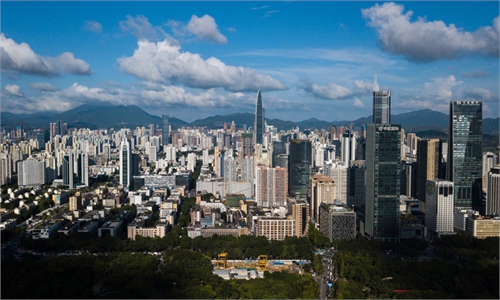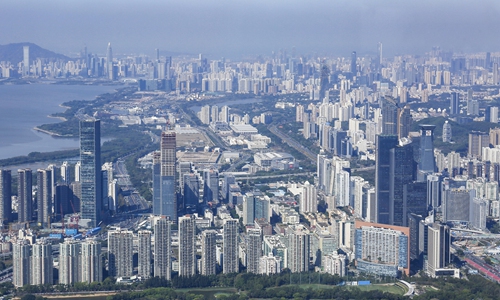COMMENTS / EXPERT ASSESSMENT
Hong Kong should seize Shenzhen’s new pilot reform opportunities

Illustration: Tang Tengfei/GT
As Shenzhen ushered in new pilot reforms on the eve of its 40th anniversary celebration as a Special Economic Zone (SEZ), it is believed that promoting further cooperation with Hong Kong will remain a focus of the SEZ's long-term development, and the cooperation will reach deeper levels and wider fields.
Although Shenzhen has enjoyed robust development in recent years with a GDP now surpassed Hong Kong, the region won't attach less importance to cooperation with its neighboring city.
Hong Kong's status as an international financial center, a high-end service industry center, and a basic scientific research center remains irreplaceable. Shenzhen and Hong Kong enjoy close cooperation in high-end education and business. Projects like the Shenzhen-Hong Kong International Center are accelerating, and the cooperation between the eastern part of Shenzhen and Hong Kong is speeding up in general - all of which demonstrates the unlimited potential of a new round of cooperation.
Hong Kong's advantages in finance, innovation and talent should make it even more inclined to take advantage of Shenzhen's new pilot reforms. By providing solid financial services, Hong Kong has served as a testing ground for the mainland's financial reforms. Hong Kong can provide unique support and experience to Shenzhen and the development of the Guangdong-Hong Kong-Macao Greater Bay Area.
Further cooperation between and integration of Shenzhen and Hong Kong will benefit the future development of the Greater Bay Area, and become a focal point for China's "dual circulation" development pattern; a pattern that has its roots in domestic development, then allows domestic and international development to reinforce each other.
To celebrate the 40th anniversary of the Shenzhen SEZ, measures to further accelerate the construction of the Greater Bay Area are expected to be announced.
The construction process of the Greater Bay Area was impacted this year by the prevention and control measures required by the outbreak of COVID-19. Against this backdrop, accelerating the construction of the Greater Bay Area will help restore confidence and support Hong Kong and Macao in rebooting their economies. The attention of all sectors of society will be brought back to economic development, further promoting the development of Hong Kong and Macao, and bringing Hong Kong's social order back on track.
As Shenzhen implements development plans for its eastern zone, more major infrastructure projects will be launched. By seizing the new infrastructure opportunity, Shenzhen and Hong Kong can jointly promote the application and innovation of new technology such as big data, Internet of Things, artificial intelligence and blockchain, all of which will help improve the innovation capabilities of the Greater Bay Area.
In addition, this will guide international high-end innovation elements to gather in the Greater Bay Area, and at the same time strengthen ties with countries and regions around the world, especially those with countries along the "Belt and Road." The development of innovation and technology in the Greater Bay Area is closely linked to the development of the world, which will help accelerate the formation of the external aspect of the "dual circulation" model.
Compared with Hong Kong, Shenzhen still has a large gap in its public services, including healthcare and education. As living standards improve, mainland residents will demand more professional, international and high-level medical and health services. Hong Kong and Shenzhen will be highly complementary in innovating in this way.
By strengthening in-depth cooperation with Hong Kong in specific areas such as healthcare, not only will those industries be helped, but it will also help to break the market segmentation of cities in the Greater Bay Area, and increase the momentum of development. This will further optimize the industrial development pattern, thereby forming a unified domestic market and ensuring the smooth flow of China's "internal circulation."
The author is chairman of the China Silk Road iValley Research Institute. bizopinion@globaltimes.com.cn


